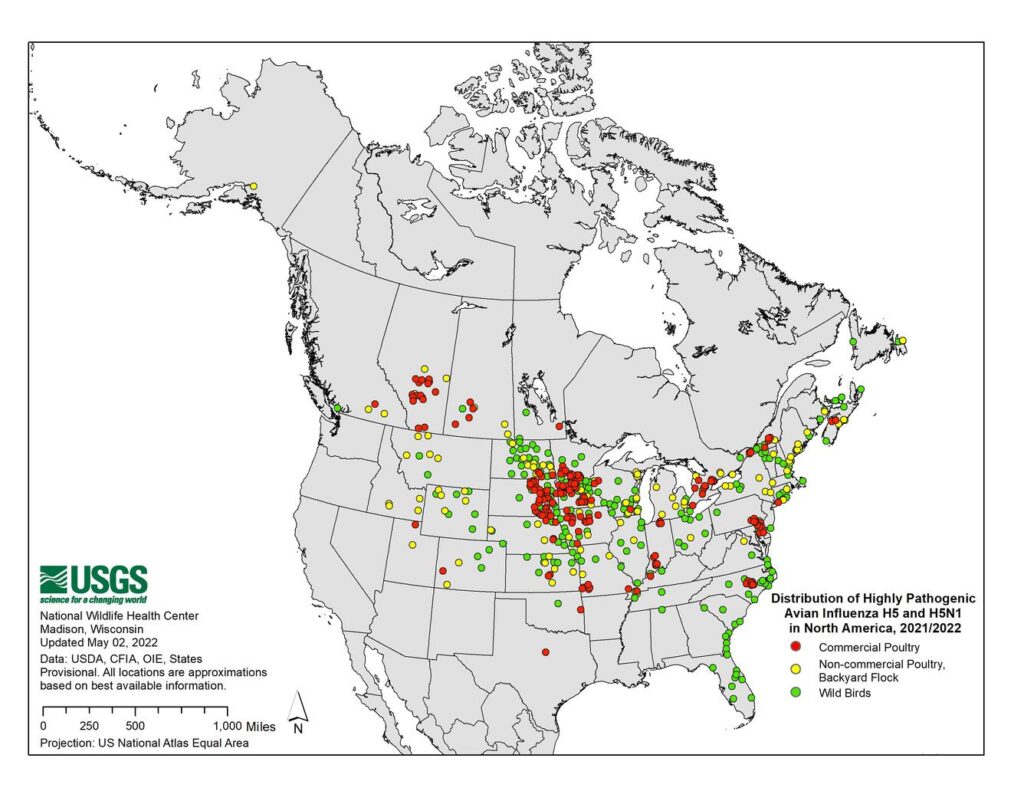HPAI H5N1 and H5

How is this year’s bird flu different from other years and strains?
This year, a new virulent strain of avian influenza has been discovered that has already killed 36 million poultry birds worldwide, either from the virus directly or from depopulating efforts to control the spread of the virus.
Experts state that this new strain is “here to stay” unlike other bird flu strains in the past, due to this virus persisting in wild birds which can then be passed to poultry farms.
While chickens and turkeys with the virus quickly sicken and die, waterfowl can remain healthy with the virus and carry it long distances. Since this new strain of flu virus was discovered in December 2021, thirty four states have tested positive for avian influenza and some of the animals infected include crows, pelicans and bald eagles.
A person has tested positive for avian influenza A(H5) virus (H5 bird flu) in the U.S., as reported by Colorado and confirmed by CDC.
This case occurred in a person who had direct exposure to poultry and was involved in the depopulating of poultry with presumptive H5N1 bird flu. The patient reported fatigue for a few days as their only symptom and has since recovered. This strain of avian influenza is not something to take lightly and we will likely be dealing with it for many months to come.

What preventative measures can I take?
Bird owners should practice good biosecurity, avoid free-ranging, and prevent contact between their birds and wild birds.
“Biosecurity” measures would include
- keeping visitors to a minimum
- washing your hands before and after coming in contact with live poultry
- Providing disposable boot covers and/or disinfectant footbaths for anyone having contact with your flock.
- Changing clothes before entering poultry areas and before exiting the property
- Cleaning and disinfecting tools or equipment before moving them to a new poultry facility
- For backyard poultry this means limiting free range exposure, especially if not monitored.
- Using an A frame with a screen over your existing poultry houses can help to keep wild birds from contacting your chickens and decrease exposure.
- Feed backyard poultry in their protected homes and do not spread seed, scratch or mealworms out for foraging in the short term. These situations lead to feeding with wild bird populations.
Hunters who handle wild birds should dress game birds in the field when possible. Wear gloves when dressing birds, and wash hands with soap and water afterwards.
Infected birds shed bird flu virus in their saliva, mucus and feces. Bird flu infections in people happen most often after close, prolonged and unprotected contact with infected birds and then the person touches their mouth, eyes, or nose.
The best method to prevent infection in humans is to be cautious around birds that may have been exposed/have the virus.
My flock likely has avian influenza, now what?
Bird owners should report sick birds or unusual bird deaths
Division of Animal Industry main line at
(850) 410-0900 during office hours
1-800-342-5869 after hours, or by emailing RAD@FDACS.gov,
or by calling USDA’s toll-free number at
1-866-536-7593.
If you must handle sick poultry:
Be sure to use protective wear (like gloves, a medical facemask, and eye protection), wash your hands with soap and water after touching birds, and change your clothes before contact with healthy domestic poultry and after handling wild birds. Then, throw away the gloves and facemask.
Sources:
https://www.cdc.gov/flu/avianflu/prevention.htm
https://www.cdc.gov/media/releases/2022/s0428-avian-flu.html
https://www.npr.org/2022/04/09/1091491202/bird-flu-2022-avian-influenza-poultry-farms
https://www.cdc.gov/flu/avianflu/avian-in-birds.htm
https://www.cdc.gov/flu/avianflu/prevention.htm
https://espanol.cdc.gov/flu/avianflu/h5/index.ht
https://www.cdc.gov/flu/pdf/avianflu/Bird-Flu-Exposure-Handout.pdf
